We already have far too many things to talk about in this Tour de France.
Kévin Vauquelin, Oscar Onley, and João Almeida have delivered some of the most surprising performances so far (in a good way), while Primož Roglič’s performances have been very disappointing. After Pogačar’s win on the Mûr-de-Bretagne, we are beginning to see the GC picture take shape.
From the steep climbs in Boulogne-sur-Mer to the 1-minute wall in Rouen, here are the power performances behind the opening act of the Tour de France.
Alpecin-Deceuninck Wins Stages 1 and 2
Crosswinds were the defining factor in the Tour’s opening stage in Lille Métropole. The lead group only contained 33 riders in the final sprint, and there were plenty of key names missing such as Jonathan Milan, Tim Merlier, and Remco Evenepoel.
Mathieu van der Poel and Kaden Groves put on a leadout clinic to deliver Jasper Philipsen to the win ahead of Biniam Girmay and Søren Wærenskjold. Philipsen pulled on the yellow jersey for the first time in his career, but it would be hard to hold onto for more than a single stage.
From Lauwin-Planque to Boulogne-sur-Mer, stage 2 featured a deceptively difficult profile with a few short climbs in the final 30 kilometers. These climbs were only 1.1km, 1.1km, and 0.8km in length, but they were exceptionally steep with average gradients between 8% and 10%.
This is where we were treated to the first big attacks of the Tour – Tiesj Benoot did what he does best, grinding up a 15% grade at over 600w. The Belgian peeled off halfway up the climb, opening the door for Matteo Jorgenson to attack. That move dragged six riders clear including Pogačar, Van der Poel, Vingegaard, Evenpoel, and Romain Grégoire. This was the first puncheur moment of the Tour, and a preview of what was to come on stage 4.
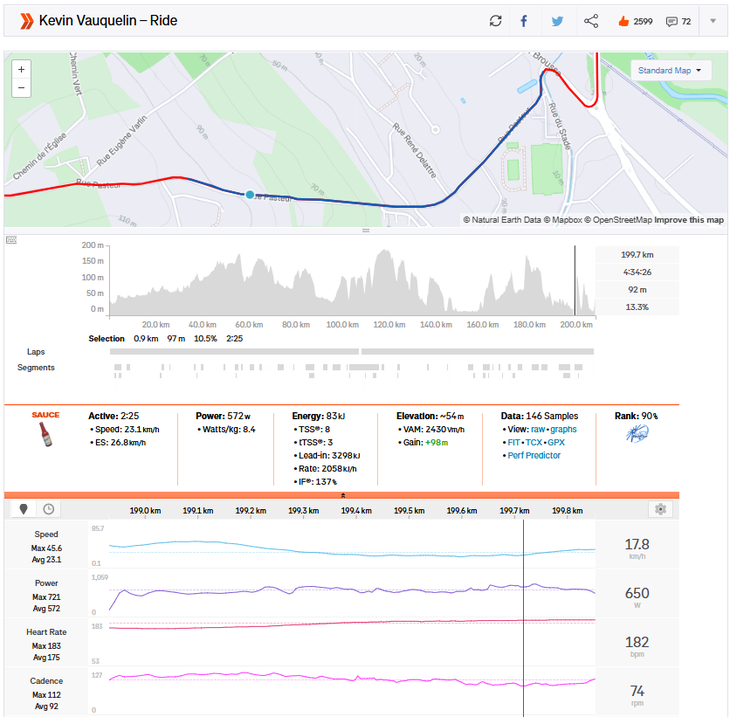
Vauquelin – Stage 2: Côte d’ Outreau
- Time: 2:25
- Average Power: 572w (8.4w/kg)
- VAM: 2,430 Vm/h
- Pogačar: 2:21 ~8.6w/kg
A number of riders came back to the leaders on the descent, so the pace was somewhat neutralized over the next few kilometers. Vauquelin, Vingegaard, and Florian Lipovitz tried to attack, but UAE Team Emirates-XRG sewed everything back together with 900 meters to go.
In classic MvdP fashion, Van der Poel led out the sprint from nearly 500 meters to go and still dusted everybody. Pogačar tried to come around him, but the world champion could hardly make up any ground, and it was Van der Poel who moved into the yellow jersey.
Pogačar’s 100th Career Win on Stage 4
We will skip over stage 3 because it was not an enjoyable watch. Philipsen crashed out at the intermediate sprint point, and there wasn’t a single rider interested in being in the breakaway. There was also a massive crash in the final sprint, which was won by Tim Merlier ahead of Jonathan Milan. Despite the large number of riders hitting the deck, there were only two abandons caused by the stage 3 crashes: Philipsen and Emilien Jeannière.
Stage 4 was another puncheur’s paradise. This route was much harder than stage 2’s, featuring four categorized climbs in the finale including the Ramp Saint-Hilaire. It was a classics-style stage that rewarded positioning, pacing, and massive 1-2 minute power. Pogačar was the favorite, but could anyone follow him?
With 5.8km to go, it was Almeida — somewhat surprisingly — doing the final leadout for Pogačar. The world champion waited until just before the steepest ramp to launch his attack. And this wasn’t just an ordinary attack, this was maybe the biggest 1-2 minute performance we have ever seen. Vingegaard was the only rider able to follow Pogačar, but even he let the wheel go 50 meters from the crest of the climb. Somehow, the Dane was able to come back, and the duo was nine seconds clear of the chasers.
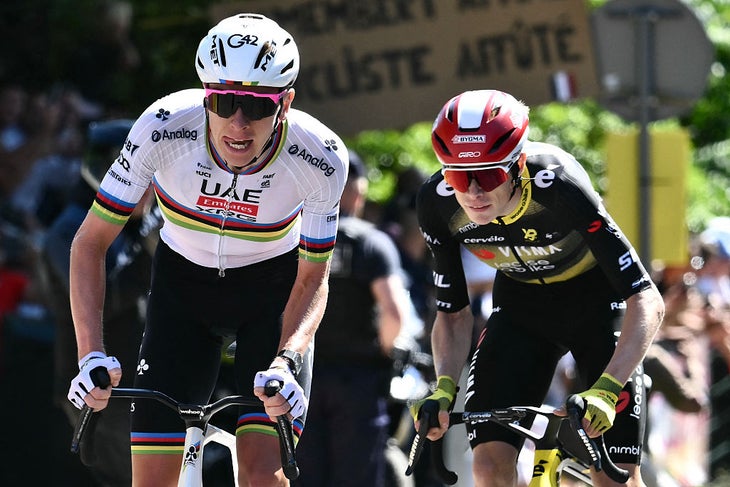
Onley was among the five riders in the chase group, and we can see the exact numbers that he was pushing on the climb. Almeida had done the leadout at nearly 10w/kg (~9w/kg in the draft), and then Pogačar had accelerated off of that pace. The world champion and Vingegaard had done nearly 2,900 Vm/h up the Ramp Saint-Hilaire, a puncheur’s performance that is difficult to put into words. Just take a look at these numbers.
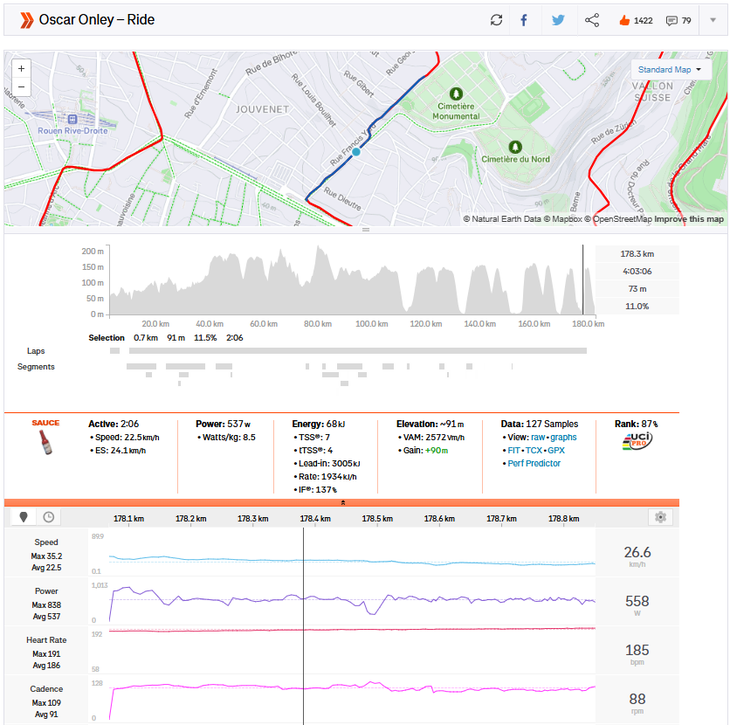
Onley – Stage 4: Ramp Saint-Hilaire
- Time: 2:06
- Average Power: 537w (8.5w/kg)
- VAM: 2,572 Vm/h
- Pogačar: 1:56 at ~9.5w/kg
- VAM: ~2,800 Vm/h
With 3.5km to go, the race started coming back together as Van der Poel, Jorgenson, Evenepoel, Onley, and others rejoined Pogačar and Vingegaard. Everything was pointing towards another MvdP win, but the Dutchman had nothing left in the legs, and it was Pogačar who won the final sprint, taking his 100th career victory.
Healy’s Signature Move Wins Stage 6
We don’t have any power numbers from the GC contenders in stage 5’s time trial, but that doesn’t take away from the significance of the result. Evenepoel took the stage win, but it was Pogačar who surprised the most by finishing runner-up, only 16 seconds behind the double-Olympic Champion. Vauquelin had one of the best TTs of his career to finish fifth – keep an eye on this 24 year-old Frenchman – and Vingegaard finished all the way down in 13th, losing 1:05 to Pogačar.
With the time gaps growing, the stage was set for a breakaway day on stage 6. It took more than 80 kilometers for the break to solidify after countless attacks on the rolling terrain. There had even been attacks from GC contenders like Jorgenson, Vauquelin, and Lipovitz, but none of them made the final move.
There were eight riders that eventually went clear: Mathieu van der Poel, Ben Healy, Quinn Simmons, Michael Storer, Eddie Dunbar, Will Barta, Harold Tejada, and this year’s Giro d’Italia winner Simon Yates. It was a ridiculously strong move, but with the gap to the peloton pegged at 90 seconds, would it be enough for the break to win the stage?
After more than two hours of non-stop racing, UAE Team Emirates-XRG finally let the gap go out to the breakaway. With around 60km to go, it was clear that the breakaway was going to fight for the stage win.
There are many different ways that you can attack in professional cycling. The most obvious time is on a steep climb. You can also attack into a descent, around a corner, or after an intermediate sprint. But only true breakaway specialists – artists, if you will – know that the best attacks are those with the highest speed differential.
For example, if you are riding along in the peloton at 45 kph, and you attack at 48 kph, it will be incredibly easy for the entire peloton to jump onto your wheel. That’s why everyone sprints when they attack on the flat, because you need to get that immediate separation.
When Ben Healy attacked with 40 km to go, he flew past the front of the breakaway at 67 kph. How? He had wound up his sprint on a small downhill leading into a short uphill. Healy had gone to the back of the group to maximize the slingshot effect that he could get from the draft. By the time he hit the wind, he was already going 12 kph faster than Barta who had just finished his pull.
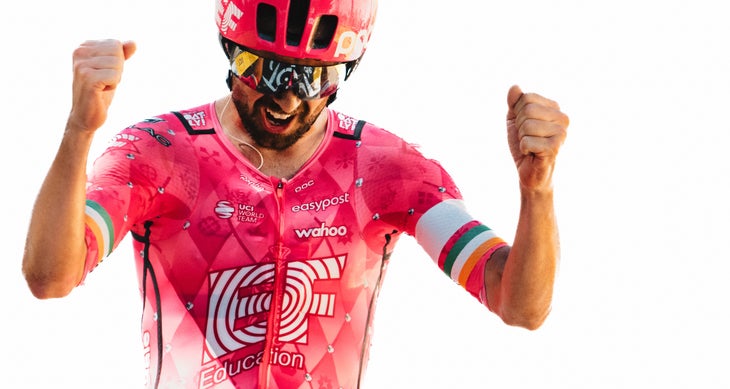
By the time Healy had 10 seconds, it was over. Simmons and Storer tried to bridge across, but they couldn’t get within 45 seconds of the Irishman. It was a Ben Healy Special: make the breakaway after two hours of fighting, roll through to create the illusion of cohesion, and then attack with 40-50km to solo to victory.
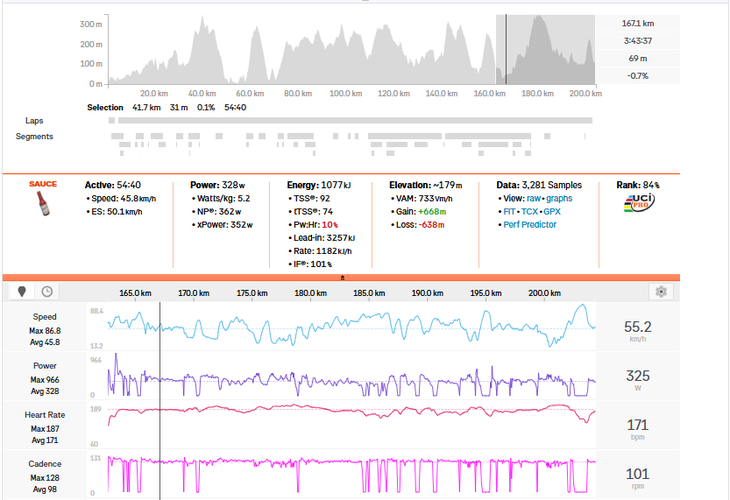
Healy – Stage 6 Breakaway Masterpiece
- Time: 4hrs 21min 26sec
- Normalized Power: 331w (5.3w/kg)
- 40km Solo: 53 minutes at 336w (NP 366w) with avg speed of 46 kph
- First 22min of the Attack: 376w (6w/kg)
After the previous day’s foray, Van der Poel’s legs went empty at the end of Stage 7 on the Mûr-de-Bretagne. Instead, it was Tim Wellens who did the final lead out for Pogačar into the final climb. But when Wellens swung off, the world champion did not attack. Instead, he continued the hard tempo until Evenepoel came over the top. But no one wanted to pull, for there was a stiff headwind, especially on the flatter and more exposed second half of the climb.
Vauquelin, Onley, and a few others caught back on as the climb leveled off, and then it was all set up for a small group sprint. Pogačar jumped first, and he gaped everyone except Vingegaard. The Dane didn’t quite have enough to come around Pogačar, and the world champion simultaneously took the stage win and the yellow jersey.
If there is a single takeaway from these first few GC stages, it is that all of these riders focused heavily on their two-minute power this season. There is a clear top 10 of riders who can do 8.5w/kg for two minutes at the end of a four-hour stage: Vauquelin, Onley, Evenepoel, Jorgenson, etc. But Pogačar and Vingegaard have separated themselves from the pack. On a good day, they can produce well over 9w/kg for two minutes at the end of a stage.
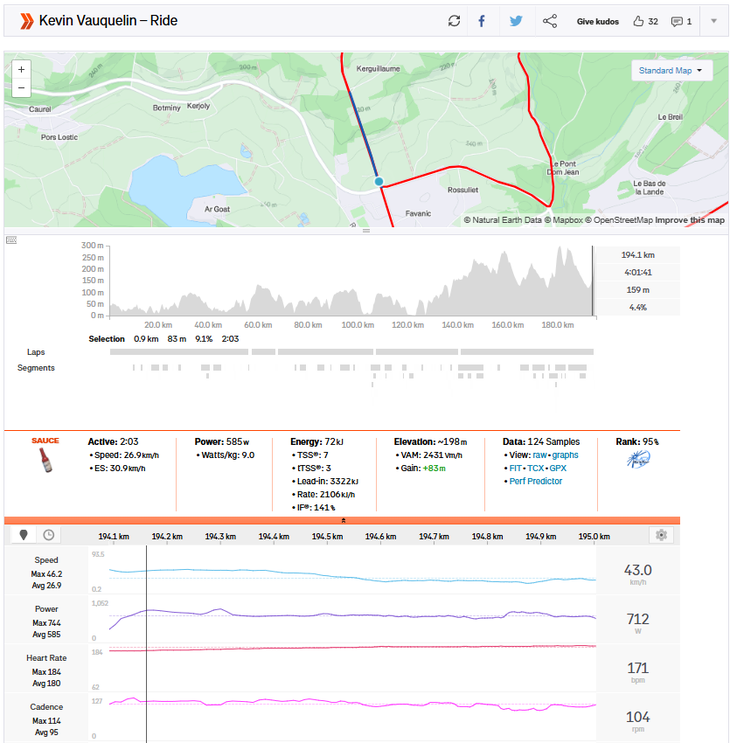
Vauquelin – Stage 7: Mûr-de-Bretagne (Steep Section)
- Time: 2:04
- Average Power: 585w (8.6w/kg)
- Pogačar: 2:00 at ~8.9w/kg into a headwind
Power Analysis data courtesy of Strava
Strava sauce extension
Riders:
